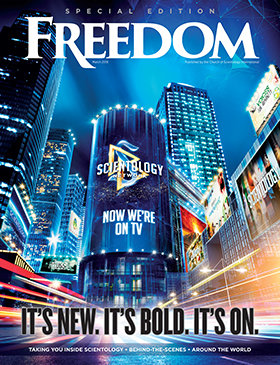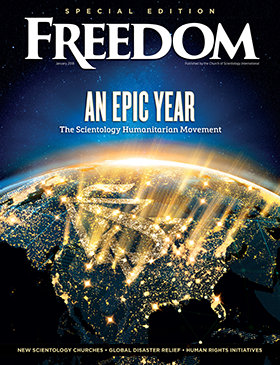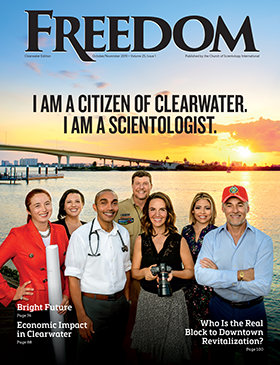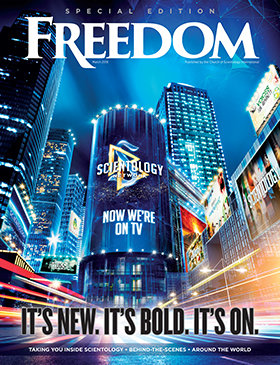Koji Minami remembers March 11, 2011 as if it were yesterday. That was the day when the Church of Scientology of Tokyo staffer felt the first rumblings of the magnitude-9 earthquake that shook eastern Japan. The tremor unleashed a series of tsunami waves that swept inland as far as six miles, triggering a meltdown in the nation’s fourth-largest nuclear power plant located in the port city of Sendai. The disaster claimed more than 15,000 lives, more than half of them from drowning. “People quickly descended into a state of shock and sorrow,” Minami recalls. “I knew I had to do everything in my power to help.”
Minami immediately left for Sendai, 225 miles away from his home in Tokyo, to coordinate the work of the Scientology Volunteer Ministers, the world’s largest independent relief force, which had arrived from around the globe to lend a helping hand in the devastated region. Team members participated in search-and-rescue efforts, manned earthquake shelters and organized the delivery of food, water and supplies. They also assisted in the cleanup of entire towns and villages that had been leveled by tsunami waves, displacing more than 300,000 residents.
The Scientology volunteers also used techniques developed by L. Ron Hubbard, the religion’s founder, intended to help victims overcome stress, toward facilitating rapid recovery from illness and injury. “We helped people to dream again, changing despair to hope,” says Minami, adding: “We were able to create minor miracles like this on a daily basis.”
Today, thanks to the efforts of volunteers and disaster relief specialists, a sense of optimism has returned to Japan. And there was new reason to rejoice when the Church of Scientology cut the ribbon on its first Ideal Organization in the Land of the Rising Sun on August 8. Ultramodern and eight stories high, the building is located in the heart of Tokyo, the world’s most populous city—and stands as a symbol of spirituality and hope for the 5 million people who pass each day through the city’s Shinjuku district, which boasts the world’s busiest train station.
More than 1,000 people attended the Tokyo Ideal Org opening ceremony, which was presided over by David Miscavige, Chairman of the Board Religious Technology Center—leader of the Scientology religion.

Describing Japan as a crossroads between East and West, Mr. Miscavige echoed the words of a Japanese poet in his address. “All futures start with today—and from here on out it is destiny!”
Mr. Miscavige also invoked the past in his speech, describing how Japan has long figured in the lore of Scientology. “L. Ron Hubbard originally approached these shores at the age of 16, in 1927. Whereupon, he came to view Fujiyama from 50 miles at sea and described it as ‘a symmetrical cone of celestial beauty.’ So it was [that] Japan well and truly left her mark on a young LRH, for it was here he saw a culture he knew ‘could influence the entire East, with thought and raised ability. I have always considered Japan the hope of Asia’.
“And so it is today,” Mr. Miscavige continued, “we now cast that ray of hope far and wide, as we inaugurate this first Ideal Org of Japan!”

The island nation is also known as the Land of Benevolence, for its cultural emphasis on having love and respect for others and for doing good. Echoing the sentiment of 17th-century Confucian philosopher Banzan Kumazawa—who coined the term—is Sei Kato, a Scientologist for the past 18 years and a native of Japan. “We have high spirituality. Our ethical standards and moral codes are something you find nowhere else in the world,” she says.
As a teenager, Kato traveled all over Japan—and through much of Asia, and then around the globe—in search of spiritual fulfillment. But it wasn’t until she returned to her home city of Tokyo that she made headway. An acquaintance introduced her to Dianetics, Scientology’s seminal book written by L. Ron Hubbard.
“In Scientology I finally found what I had been missing,” Kato says. “It was all about uncovering tools I could use to help other people—something I learned nowhere else—and I knew that if we could give Scientology to everyone on the planet, we would have a far saner world.”

It concerns Kato that Japan has gotten increasingly less religious over the years, as she puts it. It’s as if somewhere along the nation’s march toward modernity, the idea of religion, first introduced by Buddhism in the 6th century, got split off from spirituality. Today, 31 percent of Japan’s 127 million people consider themselves “convinced atheists” and another 31 percent say they are indifferent to religion, according to a 2012 poll on global religion and atheism by WIN-Gallup International.
Still, the future is bright for Scientology in Japan—given its practical and intellectual approach to spirituality and its roots in Eastern thought. “So many aspects of the religion align with Japanese culture,” says Kato.
‘And so it is today we cast that ray of hope far and wide, as we inaugurate this first Ideal Org of Japan!’
In a speech at the opening of the Tokyo Ideal Org, Masami Saito, a member of Japan’s Parliament for Miyagi Prefecture, whose capital is Sendai, praised the “skill and discipline” of the Church’s Volunteer Ministers during the 2011 earthquake and tsunami. “My wife was looking for her father,” he said, launching into a personal anecdote about the city’s devastation. “Your Volunteer Ministers were there clearing away debris from his collapsed house.”
It was through this encounter, said Saito, that he discovered the “bold spirit of the Scientologist.” Their “humanitarian attitude was touching to the core.”
Further praise of the Church’s social betterment work in Japan came from Tomoo Furubo, a member of the Toshima City Assembly in Tokyo, who recalled a 2012 The Truth About Drugs campaign that helped wipe out the commercial sale of so-called “legal herbs,” substances that were legally sold despite having been shown to cause erratic behavior, violence, illness and death among users.
“Your information gave me the solid policy I needed,” Furubo told those gathered at the opening. “Our assembly chose to officially partner with your organization. Now, move forward to today, and there are no more shops that sell ‘legal herbs’ in Japan, thanks to Scientologists.”
Furubo also spoke of the need to address what he considers recent, alarming breaches in the ethics and morality of Japan, a nation where integrity, respect and mutual cooperation historically have been highly valued. He summed up the country’s national character as “Wa,” a Japanese word meaning “team spirit” or “unity.”
The concept—first popularized in the West by American journalist and longtime Japan resident Robert Whiting in his bestselling 1989 book on Japanese baseball, You Gotta Have Wa—is embodied in the Church’s Truth About Drugs campaign, Furubo said, adding: “I expect that the actions taken by Scientologists will serve as a compass guiding our community and the people of Tokyo.”
‘In Scientology I finally found what I had been missing. I knew that if we could give Scientology to everyone on the planet we would have a far saner world.’
Takayuki Shirota, director of the Learning Support Institute of Tokyo, also spoke during the Ideal Org opening ceremony, about Scientology Study Technology—an educational method developed by L. Ron Hubbard. It’s a tool “desperately needed by Japan today” because of the nation’s “drop in scholastic ability,” he said, adding that if Japan were to implement the technology, the nation would experience nothing less than “the dawn of a renaissance of learning.”
Another speaker, Tomoki Hirabayashi, general secretary of the national nonprofit group Challenge Again Tokyo, expressed deep concern about Japan’s psychiatry-driven psychotropic drug epidemic, and the fact that ADHD, schizophrenia and other mental illnesses are “diagnosed” in the country at rates two to three times higher than a decade ago. Increasingly, “doctors, government officials and the general public [believe] that they need to go to a hospital and get medicated if they get ‘depressed,’” Hirabayashi said in a subsequent interview. “It has also become ‘common sense’ to drug children who have ‘developmental disorder’.”
Hirabayashi urged the gathered crowd to “end the over-drugging of our population at the hands of psychiatry,” and underscored the importance of informing the public about the aggressive marketing tactics of pharmaceutical companies and their worldwide affiliates. “My purpose,” he said, “is to create a culture that kids can grow up healthy in … and be of service to the world.” It’s a human rights goal, he added, that shouldn’t be difficult to achieve “with more people like [Scientologists] acting to stop these abuses.”
The Church of Scientology first established a human rights foothold in Japan in 2004. The Japan chapter of Youth for Human Rights International (YHRI), a Scientology-supported educational initiative, has carried out activities in universities and in elementary, middle and high schools across the nation, addressing more than 20,000 students so far.
YHRI Japan has also collected more than 4,000 signatures on a petition that it has filed with the Japanese Cabinet Office, calling on the government to implement a system to educate students on the Universal Declaration of Human Rights. The Church-sponsored group has also systematically protested a spate of weekly hate speeches in Shinjuku’s Korea Town. In tandem with the distribution of The Way to Happiness, a nonreligious moral code by L. Ron Hubbard, the protests have helped significantly reduce the hate demonstrations—to the extent that they have almost ceased entirely.
Scientology first came to Japan as a grassroots movement in 1962, and the Church established its official presence when it opened the Tokyo Org on the 9th floor of the Aoyama Heights building in the city’s Nishigotanda district in 1985. Before long, businessmen, often in chauffeured cars, began arriving at the Org for test evaluations and to sign up for services, according to staffer Kato. Jazz legend Chick Corea, a longtime Scientologist, helped generate further interest in the religion by giving a public lecture and seminars on art and communication while on tour in Japan in 1986.
That same year, Dianetics was first published in Japanese, leading to seminars throughout the country. In 1988, Dianetics hit the nation’s bestseller lists. (Written by Mr. Hubbard in 1950, the book is one of the most widely read of all time.) By 2007, Japanese translations of all of Scientology’s Basics Books and Lectures were made available.
The future is bright for Scientology in Japan—given its practical and intellectual approach to spirituality, and its roots in Eastern thought.
Now, Tokyo’s new Ideal Org offers Japanese Scientologists the ideal environment for religious study, with course rooms designed specifically for Scientology, and an entire floor dedicated to facilities for Scientology spiritual counseling, called auditing. There’s also a chapel for congregational gatherings, weddings and naming ceremonies. An auditorium spans the entire 8th floor of the building, and the Org also features a café, multi-use public spaces and a stunning rooftop terrace.
Like all Scientology Ideal Orgs, the Tokyo church also has an expansive public information center, where all are welcome and visitors can peruse multimedia displays and take in more than 500 films introducing the beliefs and practices of Scientology and documenting the life and legacy of the religion’s founder.
Information is also available on Church-sponsored humanitarian programs, which include Youth for Human Rights International, The Truth About Drugs, The Way to Happiness and the Scientology Volunteer Ministers. The regional activities of these social-betterment programs are coordinated at the Tokyo Ideal Org, which has the dual purpose of extending the scope and reach of Scientology’s charitable works in Asia, and will “not only light up the center of Tokyo but our entire nation with humanitarian help,” as parliament member Masami Saito put it.
Scientology leader David Miscavige echoed that sentiment in concluding his August 8 speech. “Tonight, our exalted guests spoke of a society in desperate need—and thus, exactly what this Ideal Org gives promise to. But it is not merely a promise of answers. It is the answer itself.”






























